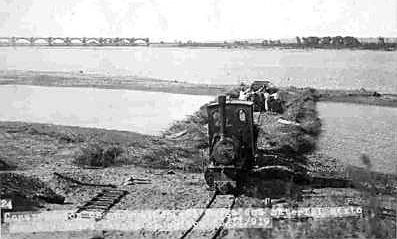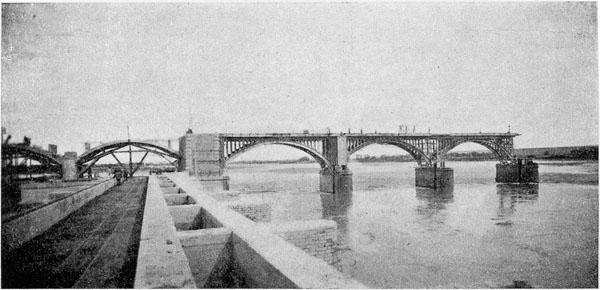Irrigation railways in the Rio Negro valley
Construction
A number of dams were constructed in the upper reaches of the rivers Neuquen and Limay, partly to control the annual flooding of the rivers but also to store the water and distribute it for farming and other purposes. The principal dam, 'El dique Contralmirante Cordero' was built on the Rio Neuquen some thirty kilometres north west of the confluence at Neuquen and a broad gauge branch was built to facilitate the construction. The principal works took place around 1912. The resulting reservoir is entitled Lago Pellagrini.

60cm gauge temporary track on a jetty during the construction works for the Neuquen barrage.

Two photos showing an O&K loco and a train of skips building up a dyke, with the barrage in the left background.


Construction works underway at the site of the barrage. The rio Neuquen is to the right and running away from the camera. The high bridge is actually over the barrage . In the foreground is the smaller viaduct over the sluices governing water flow into the main irrigation canal. It carries a 60cm gauge railway track. Behind the camera would be the entrance channel to Lago Pellagrini, the main store of water for the project.

This photo, from Arturo Coleman's autobiography, shows the completed works at the site of the Neuquen barrage. One of the barrage gates can be seen below the right hand arch. A neatly finished and obviously more permanent 60cm gauge line now crosses the viaduct in the foreground.
A network of irrigation canals eventually stretched downstream from the dam almost as far as Fuerte General Roca 70 km away. These were largely dug by steam excavators running on broad gauge tracks parallel to each side of the ditch and with bucket lines dragging the material up for dropping into 60cm gauge skips running on tracks beyond the broad gauge lines. A map of the irrigated area is available on an appendix page.
Locos and stock
Jorge Waddell suggests that the locos and wagons used in the construction of the canals had been donated by the provincial government of Buenos Aires (1).
Eventually the FCS, who operated the system, purchased a number of Orenstein & Koppel 0-4-0WTs. Rogind's history of the FCS states that 15 locos were in use in 1913 (2), though not all are identified in the table below.
Locomotives in irrigation service on the Río Negro (3)
|
Builder
|
Builder's no.
|
Wheel arrangement and power
|
 |
Ultimate fate
|
 |
 |
 |
 |
 |
O & K
|
1861 de 1906
|
0-4-0WT 30hp
|
 |
Preserved in the station yard at Neuquén
|
 |
 |
 |
 |
 |
O & K
|
5026 de 1911
|
0-4-0WT 20hp
|
 |
 |
O & K
|
5027 de 1911
|
0-4-0WT 20hp
|
 |
 |
O & K
|
5028 de 1911
|
0-4-0WT 20hp
|
 |
Preserved at Cipoletti
|
O & K
|
5029 de 1911
|
0-4-0WT 20hp
|
 |
 |
 |
 |
 |
 |
 |
O & K.
|
5160?
|
 |
 |
Possibly identified in error for Nº5745
|
 |
 |
 |
 |
 |
O & K
|
5367 de 1912
|
0-4-0WT 20hp
|
No. 8 ?
|
Preserved at Contralmirante Cordero, or at Vista Alegre North?
|
O & K
|
5368 de 1912
|
0-4-0WT 20hp
|
 |
 |
 |
 |
 |
 |
 |
O & K
|
5743 de 1912
|
0-4-0WT 20hp
|
 |
 |
O & K
|
5744 de 1912
|
0-4-0WT 20hp
|
 |
Preserved at Mono Azul, Vista Alegre Sud, Centenario for many years, then exported to Preston Services, Kent, England and sold 2005 to the Devon Railway Centre, Tiverton, England.
|
O & K
|
5745 de 1912
|
0-4-0WT 20hp
|
 |
Exported to Preston Services, Kent, England and sold 2005 to an unknown location in France
|
 |
 |
 |
 |
 |
O & K nos. 6293 and 6300 of 1913, 7076 and 7077 of 1914, 12945, 12946 and 12947 of 1937 were delivered to the Dirección General de Irrigación of the Ministry of Public Works, but their location may not have been connected with the Rio Negro works.
|
 |
 |
 |
 |
 |
O & K
|
9206 de 1920
|
0-4-0WT 20hp
|
Delivered to the FCS but use not known
|
 |
O & K
|
9207 de 1920
|
0-4-0WT 20hp
|
Delivered to the FCS but use not known
|
 |
 |
 |
 |
 |
 |

Above, is O&K no. 1861 of 1906, as seen standing in Neuquen station yard (3).

One of the O & K locos as preserved, possibly no. 5028?

Loco. no. 5367 of 1912 (3).

O&K 0-4-0T no. 5744, ex FCS, as displayed on Preston Services' webpages when for sale in 2005 and before delivery to the Devon Railway Centre at Tiverton.

O&K 0-4-0T no. 5745, ex FCS, as displayed on Preston Services' webpages when for sale in 2005, and before delivery to a new owner in France.
A railcar for inspection purposes had been purchased from the agents Donnell and Palmer in 1910 but the maker is unknown (1).
Continuing operation
The network of lines continued in use for the maintenance and cleaning of the canals at least until the late 1940s.

Further reading
More information about the irrigation schemes in the upper Rio Negro valley can be found at the following websites:
1 <http://www.inta.gov.ar/altovalle/> The Altovalle agricultural research station.
2 <http://www.oni.escuelas.edu.ar/olimpi2000/rio-negro/fruticultura/historia2.htm>.
References
1 Los Industriales de la vía Neuquén. Jorge Waddell. En Revista Todo Trenes, no. 32, octubre 2004. Buenos Aires.
2 Historia del Ferrocarril Sud 1861-1936. William Rögind, 1937. FCS, Buenos Aires
3 Details of the O & K. locos, and a pair of photos, kindly provided by Martin Murray of Bristol from his O&K records.
7-11-10
|














